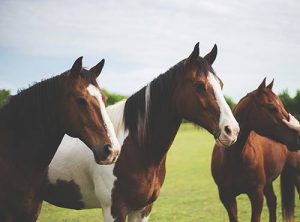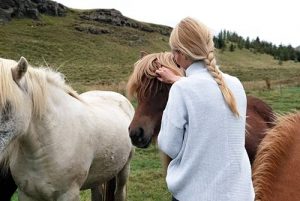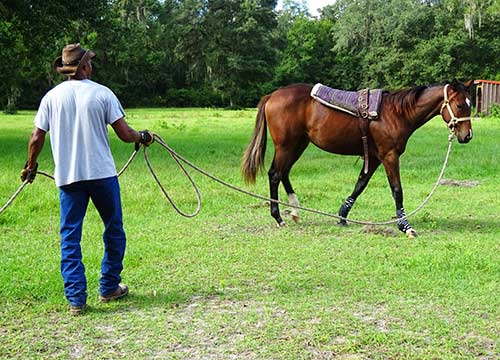Groundwork is a group of exercises you carry out with your horse while you’re leading them on the ground. We’ll run through 5 types of groundwork exercises for horses and explain what each involves so you can get your horse groundwork checklist at the ready!
Why is groundwork important

Groundwork can really build trust in your relationship with your horse. It helps set boundaries by giving instructions with a series of exercises, and builds familiarity in the relationship. Groundwork is also good for horses that can’t be ridden, it keeps them entertained while learning – so boredom won’t set in from lack of riding!
Horses are herd animals and naturally respond to a leader. Groundwork helps the horse learn, as well as the rider, and is a vital part of training. You can learn a lot about your horse from being on the ground and establish the mood or temperament the horse is in before you ride. Groundwork sets the foundations for discipline and trust.
5 types of groundwork exercises for horses
Lead exercises
These are as they sound, you lead the horse from point A to B. Leading the horse from the leading position with a halter and rope helps the horse respect your personal space. This exercise also establishes that you are the leader and you decide on the direction and pace.
Leading the horse from the partner position is a much closer movement near the shoulder of the horse. Again, you direct and set the pace for the horse and this movement should only be tried once you have comfortably managed leading from the leading position.
Practice leading at the walk, trot, halt, backing, and turning from alternate sides of your horse while he stays at your shoulder. This is really good for teaching discipline and showing who’s the boss. When you stop, he stops!
Touch exercises

Here you work with your horse to learn certain moves with your physical touch. This is another step to gaining your trust and becoming familiar with your touch – strengthening your bond. The type of touch you use depends on the relationship with your horse.
Stroking your horse with your hands over their whole body gives a sense of familiarity. Stroke all areas including the tail, under the tail, eyes, ears, mouth and so on.
Now, who doesn’t like a good back stroke or an arm tickle! When you’re grooming your horse get them used to having a good rub! You’ll find they have areas they enjoy more than others, usually around the mane but this is something you’ll learn as your relationship strengthens. A stroke/massage can also be instilled as a reward when training.
Pressure Points / Physical Aids
Physical aids are pressure points added to the horse. When the horse responds to the pressure it goes away and they know they have responded correctly. This type of training is now getting more advanced as you move through the groundwork ranks! Some pressure points that are usually activated from the leg or seat when riding can be taught and refined from the ground.
There are many different physical aids that can be taught in groundwork and below are just a few:
Head down: Light downward pressure behind the ear will encourage the horse to lower the head.
Move forward: Apply slight pressure behind the ears to take a step forward.
Nose to flank: Pressure on the side of the head for the nose to flank exercise.
Backward step: Yield to pressure slightly on the chest pushing backwards to step backwards.
Forward step: Slight pressure to the tail to encourage a step forward.
Clicker work
Clicker work can be incorporated into day to day training with your horse and can be good fun! It’s also good for teaching tricks and keeping training interesting. With clicker training, the horse learns that the behaviour that is clicked and treated will be reinforced and then repeated. It helps them learn which movements are correct when rewarded.
There are different types of clicker training but targeting is a good place to start when introducing your horse. Two types of targets are stationary and hand held, and either can be used depending on the movement you’re working on. A few simpler targeting exercises to start:
Leading: Teach the horse to follow a hand-held moving target.
Stand while tied: Teach the horse to stand on a mat or specific area.
Ground tying: Teach the horse to stand on a target or stay near a target.
Circle work

Circle work from the ground shouldn’t be too difficult to master after the previous exercises you have already completed… that said, it might not be too easy either! For this you need to use your body language and movement for the horse to follow your lead using a long lead rope to reign in if needed. Teaching this from the ground first will allow the horse to move in different gaits around the circle without the weight of a rider, and get familiar with the movement. There’s different ways you can do this and again you’ll find what works best for you and your horse.
What are you waiting for…
The average number of repetitions for a horse to pick up a new exercise is around 60 – that’s a lot of training! You must be patient, confident and calm and make it an enjoyable experience for both parties. If at any point your horse becomes uncomfortable or uneasy, take them back to a point they were enjoying training and were more relaxed, and move forward from there. Groundwork should really strengthen your relationship with your horse and be fun!
After all that training your horse needs a comfortable stable to retreat to and rest. Take a look at the Mayo Horse Comfort Mattress.

